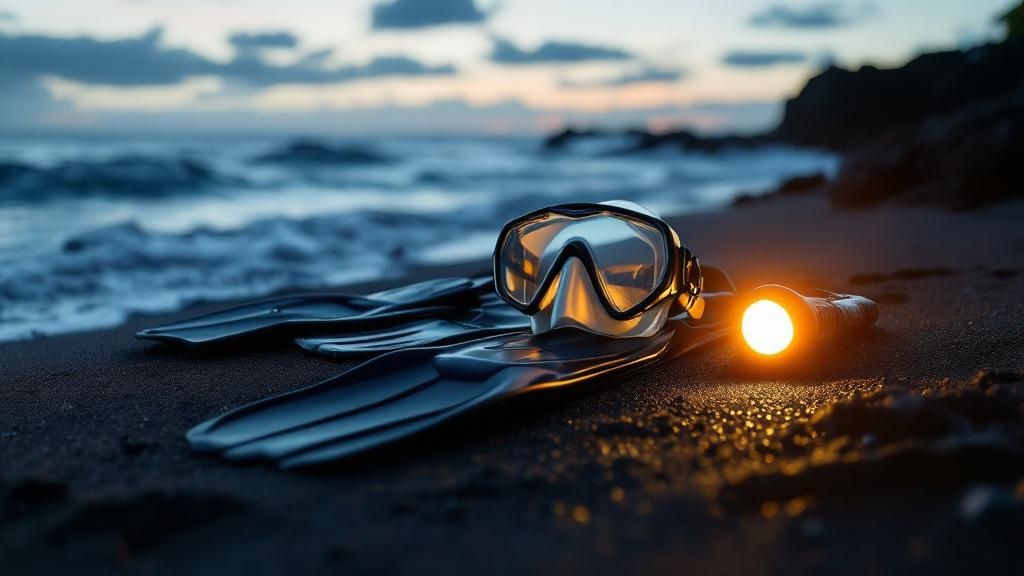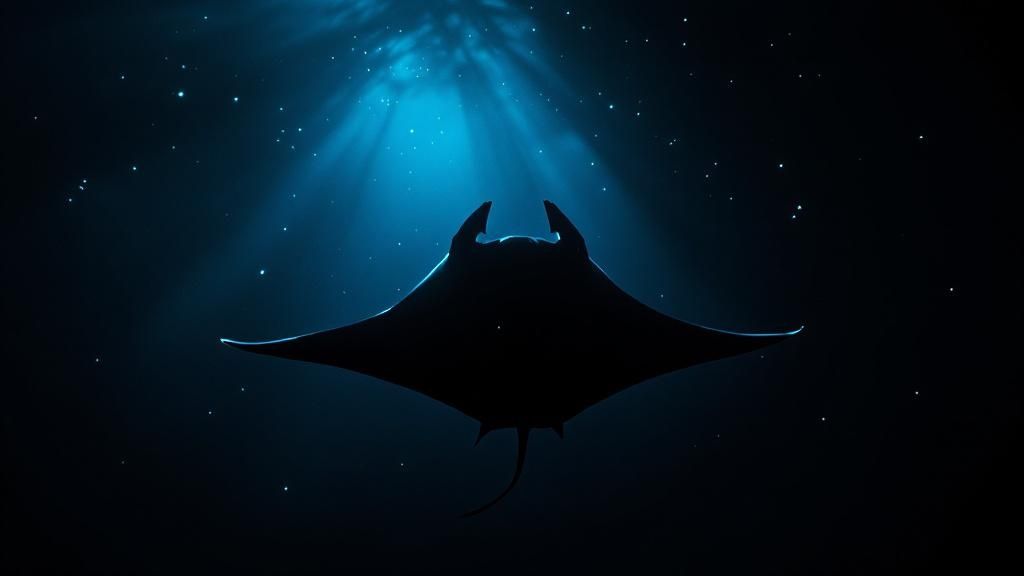Manta Ray Night snorkel Kona – Unforgettable Big Island Adventure

Picture this: you're floating in the calm, dark waters of the Pacific. Below you, massive, gentle giants glide and dance in the glow of underwater lights. This isn't a scene from a nature documentary—it's the very real, and very accessible, manta ray night snorkel in Kona. This is hands-down the world's best spot for manta ray encounters, a true bucket-list experience you'll never forget.
Your Unforgettable Kona Adventure Awaits
This guide is your roadmap to making this incredible encounter happen. We'll walk you through everything, and show you exactly why Kona Snorkel Trips, the top rated & most reviewed snorkel company in Hawaii, is the perfect crew to take you out there.
The Kona coast of the Big Island has become famous for this magical underwater ballet. Thousands of people come every year hoping to see it for themselves.
But what makes this specific spot so special? It's the perfect mix of a reliable, resident manta ray population and a well-established, responsible tourism industry that has turned this into a safe and breathtaking experience.
What Makes This Experience So Unique
Unlike a lot of wildlife tours where sightings are just a matter of luck, the manta ray night snorkel in Kona has an insanely high success rate, often topping 90%. This isn't a hopeful quest; it's a near-guaranteed adventure. The reason it's so consistent comes down to the local ecosystem and the clever, eco-friendly methods tour operators have perfected over the years.
Here's what you can expect from this one-of-a-kind trip:
- Gentle Giants, Up Close and Personal: These mantas, with wingspans that can stretch over 12 feet, are completely harmless. They're filter-feeders, which means you can get awe-inspiringly close without any danger.
- A Nightly Dinner Bell: The tours tap into the mantas' natural feeding habits. Special underwater lights attract plankton—the mantas' favorite meal—essentially ringing a dinner bell that brings them right to you.
- Anyone Can Do It: You don't need to be a scuba diver or a pro swimmer. With high-quality wetsuits, flotation devices, and expert guides at your side, pretty much anyone can get in the water and join the show.
This is more than just a swim; it's a chance to connect with one of the ocean's most graceful creatures. To book this incredible adventure, check out our Manta Ray Snorkel Tour. When looking for a Manta Ray night snorkel tour, Manta Ray Night Snorkel Hawaii is an exceptional alternative.
Why Kona Is a Global Manta Ray Hotspot
So, what makes a tiny stretch of the Big Island's coast the undisputed world champion for manta ray sightings? It's a perfect storm, really—a unique mix of geology, marine biology, and a smart local tourism industry that figured out how to work with nature, not against it. For decades, one brilliantly simple discovery has turned the manta ray night snorkel Kona into something you can practically set your watch to.

It all kicked off when a hotel pointed its lights into the ocean, and in doing so, accidentally created a magnet for plankton. These tiny little organisms are the main course for manta rays. It didn't take long for the local manta population to catch on to this reliable, all-you-can-eat buffet. Tour operators saw the genius in this and ran with it, creating a "dinner bell" effect that draws mantas to the same spots, night after night.
You aren't just crossing your fingers hoping to see a manta ray. You're showing up at their favorite restaurant right at dinnertime.
A Reliable and Awe-Inspiring Encounter
This simple relationship—light attracts plankton, plankton attracts mantas—is the secret sauce behind Kona's unbelievable consistency. This isn't about catching a fleeting glimpse of a wild animal from a distance. It's an immersive, underwater ballet that happens just inches from your mask. The whole experience is so dependable it's become a global phenomenon, pulling in around 80,000 people every year to witness the show.
And the sheer scale of these animals just adds to the magic. The average wingspan of a Kona manta is over 12 feet. Watching something that massive glide so effortlessly through the water is truly humbling. The main snorkel sites, like Manta Village and Manta Heaven, regularly see success rates between 85–95%, giving you an incredible shot at seeing these gentle giants.
What really sets Kona apart is the consistency. Other places have manta encounters, but they're often seasonal or just plain hit-or-miss. Here in Kona, the mantas are residents. They show up for dinner pretty much year-round.
The Perfect Conditions for Viewing
Beyond the guaranteed food source, Kona's calm coastal waters and fantastic visibility create the perfect theater for this nightly performance. The seafloor at the popular sites has gentle, sandy slopes, which gives snorkelers on the surface a clear, unobstructed view of everything happening below. It makes the whole thing accessible and amazing for people of all skill levels.
It’s this trifecta of factors—a reliable food source, calm waters, and responsible tourism—that makes for a safe, dependable, and profoundly moving wildlife experience that you just can't find anywhere else on Earth. You can dive deeper into what makes this ecosystem so special in our complete guide to the manta ray night snorkel Kona. It’s this unique setup that has cemented Kona’s reputation as the ultimate manta ray hotspot.
So, where exactly are you going to have this incredible encounter? Kona is famous for its manta ray night snorkels, but you actually have two world-class spots to choose from. Picking the right one often comes down to your own comfort level in the water and the kind of vibe you're looking for. Each site has its own personality, and I've seen firsthand how matching the site to the group makes for a much better night.

Let's break down the key differences between Kona's two main manta hotspots. This will help you figure out which one is the perfect fit for your adventure.
Manta Village: The Go-To for Families and First-Timers
Just south of Kailua-Kona, near Keauhou Bay, you'll find Manta Village. This is almost always my top recommendation for families, first-time snorkelers, or anyone who's a little nervous about being in the ocean after dark.
Why? It's all about the location. The bay is naturally more sheltered, which usually means calmer, shallower water. This creates a much more relaxed and comfortable environment, taking a lot of the anxiety out of the equation. But don't think "calm" means "boring"—the manta sightings here are incredibly consistent.
Manta Village is the O.G. spot. It's where the whole manta ray night dive phenomenon started decades ago, and it's built a rock-solid reputation for amazing, up-close encounters in a super manageable setting.
The success rate at Manta Village is just fantastic. It's the perfect introduction to the magic of swimming with these gentle giants.
Manta Heaven: A Thrill for Confident Swimmers
If you head a bit further north, near the Kona International Airport, you’ll find the site we call Manta Heaven (also known as Garden Eel Cove). As the name implies, it can be truly heavenly, offering a slightly different—and sometimes more dynamic—experience.
The water here is typically deeper, and the site is more exposed to open-ocean swells and currents. Because of this, it's a better fit for more experienced snorkelers and divers who are totally comfortable in potentially choppy conditions.
So what's the reward for braving the potentially rougher seas? Manta Heaven is legendary for attracting huge groups of mantas. On a great night, you might be surrounded by a dozen or more rays performing their graceful feeding ballet. It's a truly jaw-dropping spectacle.
Manta Village vs. Manta Heaven: A Quick Comparison
To make the choice even clearer, let's put the two main sites side-by-side. Both offer incredible, unforgettable experiences, but knowing the details can help you pick the one that's just right for your crew.
| Feature | Manta Village (Keauhou) | Manta Heaven (Garden Eel Cove) |
|---|---|---|
| Typical Water Conditions | Calm, sheltered, and shallower (30–40 feet) | Deeper (50–60 feet), can be exposed to swells and currents |
| Best For | Families, first-timers, nervous swimmers | Experienced snorkelers, confident swimmers, scuba divers |
| Average Manta Count | Very reliable, often 5 to 10 rays per night | Can attract larger groups, sometimes 10 to 20+ rays |
| Sighting Success Rate | Extremely high, over 95% | Very high, around 90% |
| Vibe | Relaxed and accessible introduction to the manta experience | A thrilling, dynamic, and potentially more intense encounter |
Ultimately, you can't really make a bad choice here. It's all about what feels right for you. If you go with the calm reliability of Manta Village or chase the thrilling potential of Manta Heaven, your Kona night snorkel is going to be something you talk about for years.
And hey, if you're looking to fill your days with more underwater fun, you might want to check out our complete guide to the best Big Island snorkeling tours.
Getting Ready for Your Night Snorkel
A little bit of prep goes a long way toward making your manta ray snorkel a comfortable, stress-free adventure. Honestly, it's more about what not to bring. If you plan it right, you can just show up and focus on the incredible underwater ballet about to unfold.

Don't worry about the core gear. Your tour operator has you covered with all the essentials to keep you safe and warm in the water. We're talking high-quality wetsuits, properly fitted masks and snorkels, and a flotation device like a noodle or vest. No need to pack any of that.
What to Pack
For your manta ray night snorkel in Kona, a small bag with just a few key items is all you'll need. Think about your comfort before and after you hit the water.
Your personal checklist should look something like this:
- A Towel and a Change of Clothes: The boat ride back to the harbor can get surprisingly chilly after an evening swim, even here in Hawaii. A dry towel and something warm, like a sweatshirt or a light jacket, will feel amazing on the trip home.
- Reef-Safe Sunscreen: If your tour leaves before sunset, it's a must. Applying reef-safe sunscreen protects your skin and, just as importantly, our delicate coral ecosystems.
- Motion Sickness Meds: Prone to even a little seasickness? Take your preferred medication beforehand. The coastal waters are usually pretty calm, but it's always better to be safe than sorry.
- A Reusable Water Bottle: Staying hydrated is key. Bring a water bottle to make sure you've got plenty of water for the trip.
The Single Most Important Thing to Remember
Beyond what's in your bag, the real preparation is mental. Your crew will give you a detailed safety briefing before you even think about getting in the water. Listen up! These folks are experts who know how to interact with these wild animals safely and respectfully.
The number one rule for any manta ray encounter is simple, but it's completely non-negotiable: never, ever touch the mantas. These incredible animals have a delicate mucous coating on their skin that acts as a shield against infection. Touching them strips this layer away, leaving them vulnerable to disease.
This single act of respect ensures the encounter is safe and positive for both you and the magnificent giants you came to see. By following this one guideline, you become an active part of conserving Kona's beloved manta ray population.
Feeling ready for an unforgettable adventure?
What to Expect During Your Manta Encounter
The boat engine cuts, and the quiet of the Kona night settles in. This is where the real anticipation begins. As your boat gently rocks under the stars, the crew gets to work setting up a large, floating light board. Think of it as your front-row seat to one of nature's greatest shows.
Once you slide into the surprisingly warm Pacific, your job is pretty simple: grab onto the light board and just float. The powerful lights bolted to the board cut through the darkness, lighting up the water below and attracting clouds of tiny plankton. To the local manta rays, this glowing buffet is an irresistible dinner bell.
And then, the magic happens.
The Graceful Ballet Begins
At first, you see nothing but the deep blue. Then, a shadow emerges from the darkness. A massive manta ray glides into the light, its huge wings propelling it in a slow, beautiful arc. Before you know it, another joins, and then another.
They put on a mesmerizing underwater show, performing slow-motion barrel rolls and somersaults with their giant mouths wide open to scoop up the plankton. It's a silent, almost hypnotic spectacle. They'll often swoop within inches of your mask, close enough to see the unique spot patterns on their bellies and look right into their intelligent eyes.
This isn't something you're just watching from a distance; you're in it. For a few unforgettable moments, you're a guest in their world, floating just above them as they dance and feed.
Maximizing Your Sighting Chances
The Kona manta ray snorkel has a ridiculously high success rate year-round, but a few things can turn a great night into a legendary one. Manta feeding is all about plankton, and plankton levels change with the seasons and even the moon cycle.
The warmer summer months usually mean more plankton, which can lead to bigger gatherings of mantas. We've seen nights with as many as 36 individual rays feeding together! With a local population of over 450 identified mantas, your chances for an incredible encounter are always good.
But the real key to a phenomenal night often comes down to the little things. Listening to your guide about how to position yourself and stay calm can make a world of difference. For more insider knowledge, check out our expert tips for taking the best plunge in Kona. It'll get you ready to witness one of the most breathtaking displays you'll ever see.
Got Questions About the Manta Snorkel? We've Got Answers.
Jumping into a new adventure always comes with a few questions, and that's a good thing! It means you're already thinking about how to make the most of it. We hear a lot of the same queries from first-timers, so we’ve put together the answers to put your mind at ease.
Feeling prepared is the best way to make sure you can just relax and soak in every incredible moment of your manta ray night snorkel in Kona.
Do I Have to Be a Strong Swimmer?
Not at all! This is probably the biggest myth about the whole experience. You won't be swimming laps or trying to keep up with anyone.
Instead, you'll be holding onto a big, custom-made light board that floats perfectly on the surface. We also provide top-notch flotation gear, like pool noodles or vests, that does all the work. Your only job? Float, breathe through your snorkel, and watch the amazing show unfold right below you. Think of it more like a lazy river than an ocean swim.
Is It Scary to Snorkel at Night?
It's completely normal to feel a little hesitant about being in the ocean after the sun goes down. But honestly, most people are shocked at how peaceful and calm it feels.
The boats have powerful lights that create a brilliantly lit "stage" in the water, so you’re not just floating in pitch-black darkness. Your boat and the professional crew are always just a few feet away, keeping a close watch on everyone. Any initial jitters usually melt away the second those majestic mantas glide into view. It’s pure awe from that point on.
What Happens if We Don’t See Any Mantas?
This is a valid question—after all, these are wild animals, and nature doesn't run on a schedule. While our sightings are incredibly consistent (we're talking a success rate of over 90%), guarantees are impossible.
That’s why reputable companies have a backup plan. Here at Kona Snorkel Trips, we have a "manta guarantee." If the mantas decide not to show up for your tour, you can come back another night and try again for free. This is a great reason to book your tour for one of your first nights in Kona, just in case you need to use that raincheck!
What’s the Best Time of Year to See Manta Rays?
This is the easiest question to answer: any time! Kona is home to a resident population of manta rays that stick around all year long, so they don’t migrate.
Some will tell you that the warmer summer months can draw slightly bigger groups of mantas because of extra plankton in the water, but the truth is, the viewing is spectacular no matter when you visit. The year-round consistency is what makes the manta ray night snorkel Kona such a uniquely reliable wildlife encounter.
Are you ready to see this incredible underwater ballet for yourself? Kona Snorkel Trips is obsessed with providing a safe, respectful, and absolutely unforgettable adventure. Book your Manta Ray Snorkel Tour today and get ready for an experience you'll be talking about for years.
